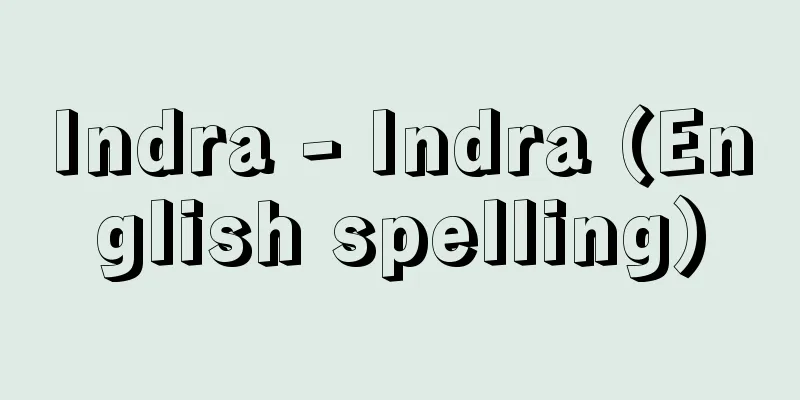Ukiyozoshi - Ukiyozoshi

|
A general term for a group of novels that primarily depict the customs of society and were written in Kyoto and Osaka for 100 years, beginning with Ihara Saikaku's "Koshoku Ichidai Otoko" (A Man Who Lived a Long Time), published in 1682 (Tenwa 2). [Tsuyoshi Hasegawa] First period (1682–1699)In the reality-affirming climate of the time, "Koshoku Ichidai Otoko" was welcomed for its novelty of ideas and depictions, and Saikaku himself, in addition to publishing erotic stories such as "Koshoku Nidai Otoko," expanded his subject matter to include stories about samurai such as "Budo Denraiki" (Record of the Martial Arts), townspeople such as "Nippon Eitaigura" (Eternal Storehouse of Japan) and "Seken Mune Sanyo" (World Calculation), and miscellaneous stories such as "Saikaku Shokoku Banashi" (Stories from Various Provinces), breaking new ground in both subject matter and method and becoming a guideline for subsequent authors. There was a work by Kyoto bookseller Nishimura Ichiroemon (Nishimurahon) from the same period, but it did not come close to Saikaku's. Saikaku's erotic stories were especially well received, and even after his death in 1693 (Genroku 6), many erotic short story collections were published in imitation of his works. Among these, Unpushi Rinko's "Amorous Hair" and Yashoku Jibun's "Amorous Mankintan" are outstanding works. [Tsuyoshi Hasegawa] Second period (1700–1711)Nishizawa Ippū's Gozen Gikeiki (Record of the Tale of the Lady Gichitsune) (1700) and Ejima Kiseki's Keisei Irojamisen (The Irojamisen in a Colored Shamisen) (1701) broke the trend of the end of the first period, which was dominated by erotic stories. The former paved the way for longer stories and more fantastical stories by using classics and drama, while the latter gained popularity for its well-organized structure, complexity, and unusual ideas. The talent of Hachimonjiya Yazaemon (pen name Jisho), the publisher of the latter in Kyoto, and the competition between Ippū and Kiseki determined the trend in the world of ukiyo-zoshi during this period. The works show the use of classics to make stories longer and the incorporation of new themes, the intricacy of the plot by introducing theatrical elements, long factual novels that take up the same events as plays, and the emphasis on structure and ideas that cover all of these. Miyako no Nishiki produced pedantic works using Japanese and Chinese classics, while Hojo Dansui, Aoki Rosui, and Getsujindou produced collections of short stories based on Japanese and Chinese tales, and Nishiki Bunryu produced long works of factual fiction. However, the conflict between Ippu and Soki ended with Soki's victory in 1711 (the first year of Shōtoku) with Soki's "Keisei Kintanki," a work that was the apex of the trend toward emphasizing taste at the time, and Ippu began to distance himself from writing Ukiyo-zoshi. [Tsuyoshi Hasegawa] Third period (1712–1735)Soki published his works through Hachimonjiya, but from around 1711 he and Hachimonjiya came into conflict over the division of profits. They reached a settlement without being able to reach a settlement in Soki's favor, but in the meantime he made an effort to produce works with new ideas in an attempt to overwhelm Hachimonjiya, and he is noted for starting works of a temperament such as Seken Musuko Katagi (1715), and for starting to write long historical novels that combined real events with the tastes and composition techniques of Joruri and Kabuki. After the settlement, the world of Ukiyo-zoshi came under the control of the book store Hachimonjiya and the author Soki, and a route was established for exporting works to Edo. It was against this backdrop that the name Hachimonjiya books was born in later years. During this period, many of Soki's works were historical novels adapted from Joruri and Kabuki, and although there was progress in the composition techniques of long novels, the tension of his earlier works was lost. This period ends with the death of the slayer. [Tsuyoshi Hasegawa] Fourth period (1736–1766)In place of Sawa, Yamozuya appointed Tada Nanrei as author. Nanrei was a scholar, but he also took up writing as a hobby, and wrote many period pieces that were adaptations of Joruri and Kabuki. His representative work is the temperamental "Kamakura Shogei Sodenikki" (1743). His works are sarcastic, full of wit, complex and technically intricate, but perhaps because they were a hobby, the quality is uneven. After his death in 1750 (Kan'en 3), his grandson Yamozu Zuisho and others published period pieces, but due to a lack of ability and the decline of the Joruri world in Kamigata, which was the foundation of period pieces, they did not perform well, and in 1766 (Meiwa 3), Yamozuya sold most of the woodblocks it had previously published to others, and retired from the forefront of Ukiyo-zoshi publishing. [Tsuyoshi Hasegawa] Fifth period (1767–1783)At the beginning of this period, Ueda Akinari published two excellent works, Shodo Kikimisekenzaru (The Listening Ears of the World of Various Ways) (1766) and Tekakekatagi (The Shape of the World's Concubines) (1767), under the pen name Wayakutaro, but it was Nagaido Kyuyu who produced many of his works, and he portrayed extreme characters who sought the extraordinary and were detached from human feelings, resulting in many mediocre works. Kichimonjiya Ichibei of Osaka published many Ukiyo-zoshi, with Taigasha Kiho (Oginobo Okuro) as the author, and he made efforts to use Chinese hakuwa novels, which were popular at the time, but due to a lack of talent, it was ineffective in reviving Ukiyo-zoshi. In contrast to the flourishing of new literature in Edo, Ukiyo-zoshi eventually declined. [Tsuyoshi Hasegawa] "Japanese Classical Literature Series 91: Ukiyo-zoshi (1966, Iwanami Shoten), edited by Noma Mitsutatsu" ▽ "A Study of Ukiyo-zoshi (1969, Ohfusha), by Hasegawa Tsuyoshi" ▽ "Japanese Classical Literature Collection 37: Kana-zoshi and Ukiyo-zoshi (1971, Shogakukan), edited and translated by Hasegawa Tsuyoshi and others" [References] | | | | | |Volume 8, by Ihara Saikaku, Kamigata edition, post-published in 1682 (Tenwa 2), National Diet Library "The Life of an Amorous Man" Volume 7 by Ihara Saikaku, published in 1687 (Jokyo 4), held at the National Diet Library "The Tale of the Introduction of Martial Arts" Volume 5 by Ihara Saikaku, published in 1688 (Jokyo 5), held at the National Diet Library "Japan Eitaigura" 1 volume, translated by Ueda Akinari, published in 1839 (Tenpo 10), held at the National Diet Library "The World of Monkeys: Hearing the Ways of Everything" Source: Shogakukan Encyclopedia Nipponica About Encyclopedia Nipponica Information | Legend |
|
1682年(天和2)刊の井原西鶴(さいかく)作『好色一代男』を起点に、100年間主として京坂で行われた、社会の風俗描写を基本的な方法とする小説群の総称。 [長谷川強] 第1期(1682~1699年)『好色一代男』は当時の現実肯定的風潮の下に、着想、描写の奇警さで歓迎され、西鶴自身『好色二代男』以下の好色物を出すとともに、『武道伝来記』などの武家物、『日本永代蔵(にっぽんえいたいぐら)』『世間胸算用(むねさんよう)』などの町人物、『西鶴諸国ばなし』などの雑話物と対象を広げ、題材、方法ともに新境地を開き、以後の作者の指針となった。同時期に京都の本屋西村市郎右衛門の作(西村本)があるが、西鶴に及ばない。西鶴の好色物はとくに歓迎され、1693年(元禄6)の西鶴没後も亜流の好色短編集が多出したが、雲風子林鴻(うんぷうしりんこう)の『好色産毛(うぶげ)』、夜食時分(やしょくじぶん)の『好色万金丹(まんきんたん)』はそのなかの秀作である。 [長谷川強] 第2期(1700~1711年)第1期末の好色物一辺倒の風潮を破ったのが、西沢一風(いっぷう)の『御前義経記(ごぜんぎけいき)』(1700)と江島其磧(えじまきせき)の『けいせい色三味線(いろじゃみせん)』(1701)である。前者は古典、演劇の利用により伝奇化、長編化の道を開き、後者は構成の整正、複雑と趣向の奇で人気を得た。後者の版元の京都の八文字屋(はちもんじや)八左衛門(号自笑(じしょう))の才と、一風、其磧両者の競作がこの期の浮世草子界の動向を定めた。古典利用による長編化と新題材の採取、演劇色導入による筋の複雑化、演劇と同一事件を取り上げての長編事実小説、それらを覆う構成、趣向の重視などが作品にうかがえる。都の錦(みやこのにしき)は和漢古典利用による衒学的(げんがくてき)な作品を出し、北条団水(だんすい)、青木鷺水(ろすい)、月尋堂(げつじんどう)などが和漢説話に題材を得た短編集を出し、錦文流(にしきぶんりゅう)に長編の事実小説の作がある。しかし一風、其磧の抗争は、1711年(正徳1)の其磧の『傾城禁短気(けいせいきんたんき)』という当期の趣向重視の傾向の頂点となる作により、其磧の勝利に終わり、一風は浮世草子の作から遠ざかるようになる。 [長谷川強] 第3期(1712~1735年)其磧は八文字屋より作品を出していたが、1711年前後より利益配分をめぐって八文字屋と抗争する。其磧に有利な解決を得られぬままに和解に至るが、その間に八文字屋を圧倒しようと新趣向の作を出すことに努力し、『世間子息気質(むすこかたぎ)』(1715)などの気質物を創始したこと、実際事件と浄瑠璃(じょうるり)、歌舞伎(かぶき)の趣向、構成法を結び付けた長編の時代物を書き始めたことは注目される。和解後、浮世草子界は本屋八文字屋と作者其磧の制圧下に置かれ、江戸移出のルートもできた。後年八文字屋本の称が生まれるのもこの全盛を背景とする。この間、其磧の作の多くは浄瑠璃、歌舞伎翻案の時代物で、長編小説構成技法の進歩にみるべきものがあるが、前期の作の緊張は失われるに至る。この期は其磧の死をもって終わる。 [長谷川強] 第4期(1736~1766年)八文字屋は其磧にかわって多田南嶺(ただなんれい)を作者に起用する。南嶺は学者であるが、余技に筆をとり、浄瑠璃、歌舞伎翻案の時代物が多い。気質物の『鎌倉諸芸袖日記(そでにっき)』(1743)が代表作である。彼の作は皮肉で才気に満ち、複雑で技巧的であるが、余技の気安さからか質的にむらが多い。1750年(寛延3)の彼の死後、自笑の孫八文字瑞笑(ずいしょう)らが時代物を出すが、力量不足のうえに、時代物の基盤であった上方(かみがた)の浄瑠璃界の衰退という事情もあり、振るわず、1766年(明和3)八文字屋は従来出版の版木の大部分を他に譲渡し、浮世草子出版の第一線から退くに至る。 [長谷川強] 第5期(1767~1783年)この期の初めに上田秋成(あきなり)が和訳(わやく)太郎の筆名で出した気質物『諸道聴耳世間猿(しょどうききみみせけんざる)』(1766)、『世間妾形気(てかけかたぎ)』(1767)は秀作であるが、気質物を多作したのは永井堂亀友(ながいどうきゆう)で、奇を求め人情を離れた極端な性格を描き、凡作が多い。大雅舎其鳳(たいがしゃきほう)(荻坊奥路(おぎのぼうおくろ))を作者に大坂の吉文字屋(きちもんじや)市兵衛が浮世草子を多く出し、当時流行の中国白話(はくわ)小説の利用など努力はみられるが、才能不足で浮世草子回生の効はなかった。江戸の地の新興文学隆盛に反し、浮世草子はやがて衰滅するのである。 [長谷川強] 『野間光辰校注『日本古典文学大系91 浮世草子集』(1966・岩波書店)』▽『長谷川強著『浮世草子の研究』(1969・桜楓社)』▽『長谷川強他校注・訳『日本古典文学全集37 仮名草子集・浮世草子集』(1971・小学館)』 [参照項目] | | | | | |巻8 井原西鶴著 上方版 1682年(天和2)跋刊国立国会図書館所蔵"> 『好色一代男』 巻7 井原西鶴著 1687年(貞享4)刊国立国会図書館所蔵"> 『武道伝来記』 巻5 井原西鶴著 1688年(貞享5)刊国立国会図書館所蔵"> 『日本永代蔵』 1巻 和訳太郎(上田秋成)著 1839年(天保10)刊国立国会図書館所蔵"> 『諸道聴耳世間猿』 出典 小学館 日本大百科全書(ニッポニカ)日本大百科全書(ニッポニカ)について 情報 | 凡例 |
<<: Ukiyogara Hiyoku no Inazuma - Ukiyogara Hiyoku no Inazuma
>>: Ukiyo-e Study - Ukiyo-e Study
Recommend
Mugaku Sogen
A Rinzai monk from the Kamakura period who came t...
Coastal upwelling ecosystem research
...The group was comprised mainly of American mar...
Miya Enginkyoku - Kyuen Ginkyoku
A long Vietnamese poem written by Nguyen Gia Thieu...
Merwedekanaal - Merwedekanaal (English spelling)
A canal in the Netherlands. It starts at Gorinchem...
Kaesong
A city in the southern part of North Korea. Popul...
Free electrons
Electrons move freely in a vacuum or in a substan...
CI - C-I
CI (corporate identity) is the use of a graphical ...
Papora
…Saisiyat and Pazeh, a Ping Pu language, are not ...
Sadness, sorrow
Grief is an emotion caused by a situation that is ...
Gazette de France
A newspaper founded by T. Renaud on May 30, 1631, ...
seven deadly sins
In Buddhism, sin is an act that goes against the ...
Mr. Inagaki - Inagaki-uji
A feudal lord in the early modern period. He is sa...
Practice - Practice
Psychologically, practice is explained as the rep...
Suslov - Mihail Andreevich Suslov
Soviet politician. Born on November 21 in Saratov...
Ministry of Foreign Affairs - Takumusho
This was the central government agency that manag...









